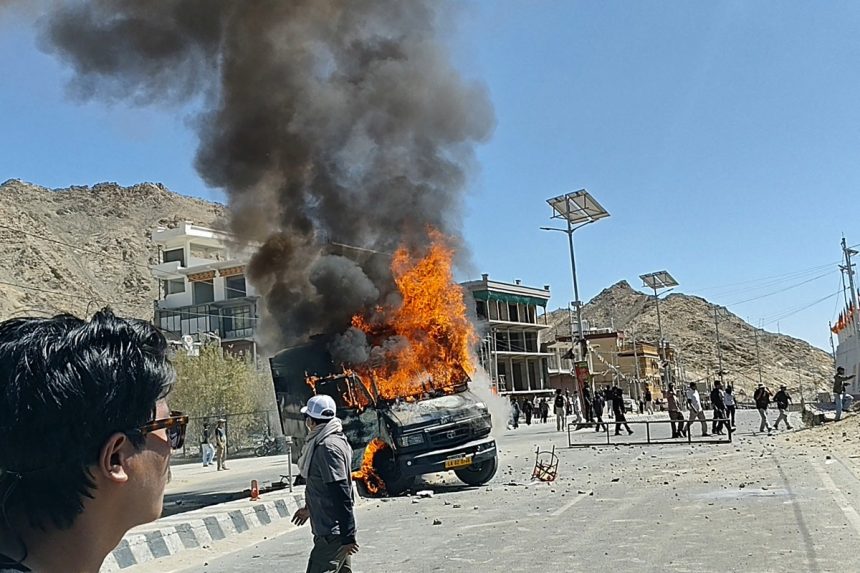Ladakh, a high-altitude cold desert region in the Himalayas that has been at the heart of recent India-China tensions, was rocked on Wednesday by violent Gen Z-led protests as youth torched the regional office of Indian Prime Minister Narendra Modi’s Bharatiya Janata Party (BJP).
As protesters, including school students, clashed with the police in Leh, the regional capital, at least four of them were killed and dozens were injured, protest coordinators told Al Jazeera, following additional deployment of the armed forces. Authorities said dozens of security forces were also injured in the clashes.
For the past six years, thousands of people in Ladakh, led by local civic bodies, have taken out peaceful marches and gone on hunger strikes demanding greater constitutional safeguards and statehood from India, which has governed the region federally since 2019. They want the power to elect a local government.
On Wednesday, however, groups of disillusioned youth broke with those peaceful protests, said Sonam Wangchuk, an educator who has been spearheading a series of hunger strikes.
“It was an outburst of youth, a kind of Gen-Z revolution, that brought them on streets,” Wangchuk said in a video statement, referring to recent uprisings in South Asian countries, including in Nepal earlier this month, that led to the overthrow of the government of Prime Minister KP Sharma Oli.
So, what’s happening in Ladakh? What are their demands? How did the Himalayan region get to this point? And why does the crisis in Ladakh matter so much?
Smoke rises from a police vehicle that was torched by the demonstrators near the Bharatiya Janata Party (BJP) office in Leh on September 24, 2025. Indian police clashed with hundreds of protesters demanding greater autonomy in the Himalayan territory of Ladakh, leaving several people injured, authorities said [Tsewang Rigzin /AFP]
What triggered clashes in Ladakh?
On Wednesday morning, a hunger strike by local Ladakhi activists, led by the Ladakh Apex Body, an amalgam of socio-religious and political organisations, entered its 15th day.
Two activists, aged 62 and 71, had been hospitalised the previous evening after two weeks of hunger strike, leading to a call by organisers for a local shutdown. The protesters were also angry with the Modi government for delaying talks with them.
These issues led the youth to believe that “peace is not working”, Wangchuk said on Wednesday evening in a virtual press meeting, during which he appeared frail.
Then the youth-led groups broke away from the protest site in Leh at the Martyrs’ Memorial Park and moved towards local official buildings and a BJP office, raising slogans, leading to clashes with the police. Four were killed and another remains critical, while dozens were injured.
“This is the bloodiest day in the history of Ladakh. They martyred our young people – the general public who were on the streets to support the demands of the strike,” said Jigmat Paljor, the coordinator of the apex body behind the hunger strikes.
“The people were tired of fake promises for five years by the government, and people were filled with anger,” Paljor told Al Jazeera. Amid the violence, he said, his organisation withdrew the hunger strike, calling for peace.
In a statement, India’s home ministry said that clashes “unruly mob” had left over 30 forces personnel injured — and that “police had to resort to firing” in self defence, leading to “some casualties”.
The government said that “it was clear that the mob was incited by [Wangchuk]”, adding that the educator was “misleading the people through his provocative mention of Arab Spring-style protest and references to Gen Z protests in Nepal.” Wangchuk has been warning that youth sentiments could turn to violence if the government does not pay heed to the demands of peaceful protesters — but insists he has never advocated violence himself.
What do protesters want?
In 2019, the Modi government unilaterally stripped the semi-autonomous status and statehood that Indian-administered Kashmir had previously enjoyed under the Indian constitution.
The state had three regions – the Muslim-majority Kashmir valley, the Hindu-majority Jammu, and Ladakh, where Muslims and Buddhists each form about 40 percent of the population.
Then, the Modi government bifurcated the erstwhile state into two territories: Jammu and Kashmir with a legislature, and Ladakh without one. While both are federally governed and neither has the powers of other states in India, Jammu and Kashmir’s legislature at least allows its population to elect local leaders who can represent their concerns and voice them to New Delhi. Ladakh, locals argue, doesn’t even have that.
Kashmir is a disputed region between India, Pakistan and China – the three nuclear-armed neighbours each control a part. India claims all of it, and Pakistan claims all except the part held by China, its ally. Indian-administered Kashmir borders Pakistan on the west, and Ladakh shares a 1,600km (994-mile) border with China on the east.
Since the end of statehood, Ladakhis have found themselves under the rule of bureaucrats. More than 90 percent of the region’s population is listed as Scheduled Tribes. That status has prompted a demand for Ladakh to be included under the Sixth Schedule of the Indian Constitution, which provides autonomous administrative and governance structures to regions where recognised Indigenous communities dominate the population. There are currently 10 regions in India’s northeastern states that are listed under the schedule.
However, the Modi government has so far resisted both statehood and the protections of the Sixth Schedule for Ladakh.
The separation of Jammu and Kashmir from Ladakh has meant that it is harder for Ladakhis to find work in Jammu and Kashmir, where most jobs in the previously unified region were. Since 2019, locals have also accused the Indian government of not putting in place clear policies for hirings to public sector jobs.
“[The young protesters] are unemployed for five years, and Ladakh is not being granted [constitutional] protections,” Wangchuk said on Wednesday. “This is the recipe of social unrest in society: keep youth unemployed and then snatch their democratic rights.”
Ladakh has a 97 percent literacy rate, well above India’s national average of about 80 percent. But a 2023 survey found that 26.5 percent of Ladakh’s graduates are unemployed – double the national average.
On Wednesday, the anger tipped over.
“What’s happening in Ladakh is horrific,” said Siddiq Wahid, an academic and political analyst from Leh. “It is scary to see Ladakh sort of pushed to this edge.”
“In the last six years, Ladakhis have realised the dangers that their identity faces,” he said, adding that the people have been “adamant about the need to retrieve their rights since they were snatched away six years ago”.
“The youth anger is a particularly worrisome angle because they’re impatient. They’ve been waiting for a resolution for years,” said Wahid. “Now, they are frustrated because they don’t see a future for themselves.”

An Indian security personnel stands guard near the Siachen base camp road, in Ladakh’s remote Warshi village [Sharafat Ali/Reuters]
Have there been protests earlier in Ladakh?
Yes. Since the abrogation of the region’s semi-autonomous status and the removal of statehood, several local civic groups have staged protest marches and at times gone on hunger strikes.
Wangchuk, the educator, has led five hunger strikes in the last three years, demanding constitutional protections for Ladakh. He is also the most well-known face of the protests in Ladakh – having a wider reach due to his past sustainability innovations. Wangchuk’s life has also inspired a Bollywood blockbuster movie that has also gained legions of fans in China.
The site of the hunger strike, the Martyrs’ Memorial Park, is also dedicated to three Ladakhis who were killed in August 1989 in a firing incident during protests. At the time, the protests were over anger about perceived Kashmiri dominance in the unified state that Ladakh, Jammu and Kashmir belonged to.
The site also honours two other protesters who were killed in January 1981 during an agitation demanding Scheduled Tribe status for Ladakhis.
But Wednesday’s protest marked the deadliest day in Ladakh’s political history.
Sajad Kargili, a civil member of a committee constituted by the Modi government to speak with the protesting activists, said that the violence in Ladakh “highlights the frustration of our youth”.
“The government needs to understand that there are young people here who are angry and not opting to sit on a hunger strike,” Kargili said. “The Modi government should not turn its back on these calls.”

Military tankers carrying fuel move towards forward areas in the Ladakh region, September 15, 2020 [Danish Siddiqui/Reuters]
Why Ladakh is so significant
Ladakh sits at India’s Himalayan frontier, bordering China.
The region also connects to vital mountain passes, airfields, and supply routes that are critical for India’s military in the event of a conflict with China. In 2020, the Indian and Chinese forces clashed in eastern Ladakh along the Line of Actual Control (LAC), following a Chinese incursion.
At least 20 Indian forces personnel were killed alongside four Chinese. The confrontation triggered the mobilisation of tens of thousands of troops on both sides, with heavy weaponry and infrastructure being rushed to high-altitude posts.
Since then, Ladakh has remained the nerve centre of India-China border tensions. Multiple rounds of military and diplomatic talks have led to a thaw since late last year.
Now, Wahid, the political analyst, said that the Modi government’s actions in 2019 are returning to haunt India with a new threat in Ladakh – an internal one. Indian authorities, he pointed out, have long had to deal with Kashmir as a “centre of discontent”. Now, they have Ladakh to contend with, too.









